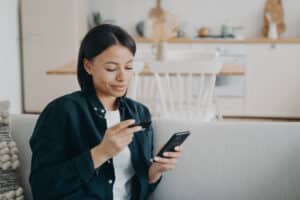
Open banking is all about using secure API to facilitate the sharing of financial information without requiring consumers to provide login credentials to third parties to use their services.
The United Kingdom has already implemented this transformative API, and now other countries are following suit.
Financial institutions, legal experts, and fintech startups are all bracing for widespread deployment of the open banking API. As a result, analysts expect the open banking market to continue to grow, projecting the market to increase from US$19.14 billion in 2022 to $48.13 billion in 2026, an impressive CAGR of 25.9%.
What is fintech?
Fintech, or financial technology, is a term used to describe companies specializing in financial technology solutions. Popular fintech companies include QuickBooks, Square, Wealthsimple, and other similar financial service companies.
Canada is gearing up to implement open banking by formalizing processes and releasing a comprehensive framework to regulate and secure the API. In addition, Canada’s implementation includes an accreditation process to protect consumers and financial institutions.
Open banking is expected to continue to be deployed throughout much of the world, with proponents advocating increased competition, transparency, and ease of use for consumers.
But how will this new API impact banks and financial services? Keep reading to explore how we believe Canada’s upcoming open banking implementation will affect financial institutions.
What Exactly is Open Banking?
Open banking is an application programming interface (API) that allows organizations to securely share customer data without requiring the customer to provide login credentials to a third party.
Without open banking, a practice known as screen scraping is employed to obtain a consumer’s banking information and provide it to a third party. However, screen scraping requires authentication information to be provided, stored, and frequently accessed.
Screen scraping allows for introduces several risks that open banking attempts to solve, such as:
- Malicious apps designed to steal login information
- Data breaches or other cyber attacks
- Malicious use from internal parties
So, open banking establishes a standard for sharing financial data between parties without requiring the consumer to provide credentials — instead, they simply authorize data sharing.
Consumers are better protected, and banks have clear responsibilities and liabilities for any issues that may arise, depending on the country and established framework.
What Data Will the Open Banking API Transfer?
Banks and fintechs will now be able to securely share a wide range of data with each other without transmitting any login information. However, these financial institutions will still be transmitting sensitive data, including:
- Account type
- Account balance
- Name on the account
- Date of opening the account
- Transactions and associated data
- Payment details
You can see that even though login credentials never have to be shared, there is still a significant need for security during transmission and ensuring only legitimate parties can access open banking.
Canada will have a formal accreditation process before any party can use the open banking API. Additionally, technical specifications and standards to ensure security will be required, which may include:
- OAuth2
- HTTPS
- JWT
- HMAC
- XML sig
- CORS
- WS-I
The open banking API is designed to improve security but also invites new security risks that must be guarded against. The formal accreditation process and required technologies help minimize these risks.
You may also notice that many of these technologies are also the foundation of strong Identity and Access Management (IAM), making getting started with IAM now a great way to prepare for open banking.
How Will Open Banking Work Once Implemented?
Banks and fintechs will be ready to use open banking after Canada has formalized its regulations, framework, and processes. But how will it work, exactly?
Let’s take a quick look at the consumer perspective of this process:
- A consumer finds an app for managing their finances
- During setup, the app prompts the consumer to link their bank
- Consumer authorizes the bank to share financial data with the app via open banking
- Financial data is now securely shared between the financial institution and the app
The consumer never needs to provide their bank login credentials; instead, they simply provide data sharing consent.
How will it look for banks and fintechs? In most situations, the process will be entirely automated. Instead, accredited organizations will need to implement the right technologies and processes to accommodate open banking as described in Canada’s upcoming framework.
How Will Open Banking Impact Banks & Financial Institutions?
Canada is currently finalizing its framework to regulate open banking, establishing standards, and accreditation processes. Once finalized, we’ll be able to hone in on how it will affect banks and start seeing those effects take shape.
For now, we can still speculate about how the full deployment of this API impacts the financial services sector. Let’s explore a few ways we see open banking impacting banks:
Propel Innovation and Create Competition
Open banking will make accessing bank data easier for fintechs and other financial services. This ease of access will allow existing companies to improve services and likely give birth to entirely new ways to use the readily available data. Banks themselves can also re-evaluate and improve their own value-added services.
Consumers will appreciate simplified services and be able to trust new innovations that may improve their lives. In addition, since they don’t need to provide any login information, it’s easier and safer to try out a new service than with screen scraping.
Ultimately, open banking means banks will need to put in more effort to retain and attract customers, as releasing the monopoly on bank information will spur innovation.
Reduce Friction
Data processing and transferring with existing methods frustrate consumers and businesses. On top of the trust required to provide a new application with login credentials, importing and processing data can often fail due to incorrect standards or formatting.
Open banking establishes standards for transferring financial data. As a result, banks will be able to allow external organizations to access and retrieve data, creating an improved experience for both users and financial institutions.
Clear Liability
While not an inherent part of the technology, countries implementing open banking will likely establish liability for any data breaches or security issues that expose consumer data. Existing screen scraping methods often lack clear guidelines about which party is responsible for data breaches. It also may violate the terms and conditions laid out by the bank.
As Canada and other countries enact open banking, clarifying responsibilities and penalties for these situations will significantly benefit banks and fintechs. Enterprises will be able to openly share information while being fully aware of liability should a breach occur.
Are There Any Risks to Financial Institutions from Open Banking?
Open banking may improve security by removing login credentials and establishing practices for data sharing. However, there are still some risks banks, and fintechs need to be aware of them when proceeding with open banking:
- Potential for more damaging data breaches: Open banking will mean more parties will have sensitive information, which means a data breach can be incredibly damaging.
- Insider threats throughout the network: A malicious actor inside an accredited company may misuse their access levels to leak data outside the organization.
- Malicious apps can be devastating: An app or website using the open banking API can phish customers, similar to screen scraping methods.
Each of these risks can create significant issues for financial institutions. However, these potential issues are also why Canada and other countries are moving slowly and cautiously toward full implementation.
Canada will accredit every organization before it can use the open banking API. Additionally, strong security practices will be reviewed and enforced.
As discussed above, one significant benefit of open banking is establishing liability should one of these risks become a reality. This avoids the confusion and fines that can occur with screen scraping and instead clearly dictate the responsible party for the given scenario.
Deploy Leading-Edge IAM Now to Prepare for Open Banking
Open banking is undoubtedly set to transform the entire financial services industry. As Canada progresses with finalizing its open banking framework, banks and fintechs can now prepare by upgrading Customer Identity and Access Management (CIAM) protocols.
IAM is a series of technologies and processes that use leading-edge technologies to strengthen how you manage internal and external users. Enacting effective IAM policies now ensures you have the proper security to begin the upcoming open banking accreditation process.
Yet, IAM isn’t a single platform or technology you can easily buy and deploy. So it’s well worth choosing an experienced IAM partner to help you upgrade how you manage accounts through your enterprise.
Indigo Consulting is an industry leader in IAM, and we’re ready to help you upgrade to the latest processes and technologies to manage and secure your users. Ready to discover how we can help? Contact us today to speak to an IAM expert to learn more.






